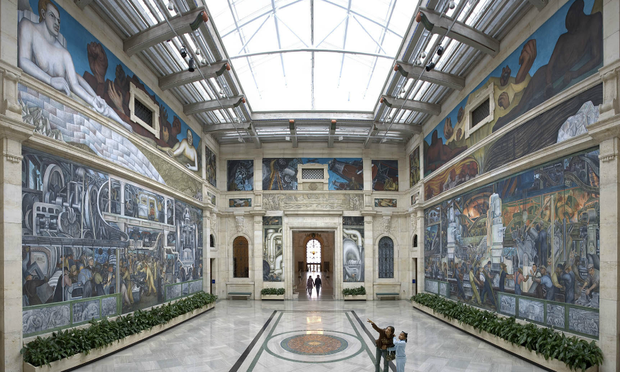Art & Exhibitions
Will $4 Billion Art Loan Derail Detroit’s Grand Bargain?
Art Capital Group proposal could split bankruptcy court vote.

Art Capital Group proposal could split bankruptcy court vote.

Eileen Kinsella

As Detroit’s massive bankruptcy reorganization proceedings continue to move forward, all eyes are once again focused on the major collection of the Detroit Institute of Art (DIA) as observers continue to fret about how the city’s financial difficulties could impact the arguably priceless collection.
A more recent participant to enter the fray is lender Art Capital Group, run by CEO and founder Ian Peck, which has proposed a staggering loan of as much as $4 billion to the city of Detroit. The collateral? DIA’s sprawling art collection. That offer undoubtedly looks enticing to some of the city’s creditors as a possible restructuring option. It will surely halt or at least slow Detroit’s efforts to gain approval for its so-called “grand bargain,” which is expected to yield some $816 million and would settle, among other matters, “various issues relating to DIA.”
The broad terms of the grand bargain were outlined in a July 15 report from Detroit’s office of the emergency manager, Kevyn D. Orr, who was specially appointed by the city. Indeed, according to a New York Times report this morning: “Details of Art Capital’s proposal came from a term sheet, marked ‘proprietary and highly confidential,’ that was provided to The New York Times by a person opposed to the grand bargain.”
At publication time, Orr’s office had not responded to artnet News’s requests for comment about the loan offer. In response to an email to DIA, representative Pam Marcil said: “This is a question that should be directed to the City of Detroit, since this is a proposal addressed to them, not to us. Our position is the same, the collection cannot be sold or collateralized. It is held in trust for the public.”
Past reports of aggressive tactics by Art Capital Group, including reportedly contentious dealings with photographer Annie Liebovitz, who at one point ran the risk of losing her entire photo archive over an outstanding $20 million loan, and separately to collector Melanie Gill, will certainly raise a red flag for some and serve as ammunition for those opposed to the loan offer.

The Detroit Institute of Arts. Photo via: I Love Detroit Michigan.
Meanwhile, Art Capital Group spokesperson Montieth Illingworth told artnet News via email: “We’re prepared to provide a loan, secured by the art collection, that is a balanced, fair, and equitable solution for the city so that it can emerge from bankruptcy with the money it needs to secure a better future. Only our loan does that. The Grand Bargain doesn’t.”
Illingworth points out that appraiser Victor Weiner valued the collection at over $8 billion. The value of the collection has varied widely, based on who is appraising it—including at various points Christie’s and Artvest partners—as well as divergent views about the status of gifted artworks or the feasibility of selling top-notch pieces on the open market. In museum circles, observers have pondered the possible black mark against a wealthy buyer or museum taking advantage of a troubled situation to snap up works that would rarely, if ever come on the open market again.
According to Illingworth, ACG is flexible and willing to tailor the loan meet Detroit’s specific needs. “If the city decides it needs only $50 million to start with, then we’ll provide that money.” He says that comparing the loan offer to the grand bargain is “simple dollars and cents. The Grand Bargain essentially sells the DIA’s collection to the city for what amounts to $400 million, in terms of the present day dollar value of the purchase price. That’s all the city gets from a collection worth $8 billion to help it emerge from bankruptcy.”
Asked about the possibility of default and how it would affect the collection, Illingworth said the goal is to do everything possible to keep the collection “in the city and intact…There is a lot we can do to make the loan manageable so that the art collection continues to be protected.”
Walter Liedtke of the Metropolitan Speaks
In a November 2013 panel in New York, at which DIA director, president, and CEO Graham Beal Jr. was present, art experts discussed the difficult issues surrounding any sale or monetization of the collection. Walter Liedtke, curator of European paintings at the Metropolitan Museum of Art, said: “The important thing to say is that institutions like yours, like my museum—the curators in my department would all resign if the Metropolitan Museum placed a single bid for any one of your objects, even in another department. I know that’s true.”
New York dealer Richard Feigen, never afraid to speak his mind, likened the possibility of a sale to a notorious 1939 Nazi sale of “degenerate art” at Galerie Fischer in Lucerne, the shadow of which still looms over the works that were sold. He rejected one audience member’s suggestion that an interested buyer, then or now, might feel they were saving or protecting the works. “The Nazi regime took them off the wall and put them up for sale,” Feigen said. “Theses were things for which they thought they could get money.”
And David Nash, another New York dealer, argued that the idea of the art world heroically resisting a sale was unrealistic. “I would like to like to think that,” he said. But “there are dozens of very rich buyers outside the country, including in Qatar, Russia, and perhaps China” that might step up.